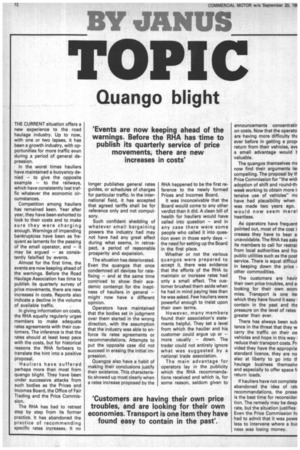BY JANUS
Page 74

If you've noticed an error in this article please click here to report it so we can fix it.
TOP C
Quango blight
THE CURRENT situation offers a new experience to the road haulage industry. Up to now, with one or two lapses, it has been a growth industry, with opportunities for more traffic even during a period of general depression.
In the worst times hauliers have maintained a buoyancy denied — to give the opposite example — to the railways, which have consistently lost traffic whatever the economic circumstances.
Competition among hauliers has remained keen. Year after year, they have been exhorted to look to their costs and to make sure they were charging enough. Warnings of impending bankruptcies have been as frequent as laments for the passing of the small operator, and — it may be argued — as consistently falsified by events.
Almost for the first time, the events are now keeping ahead of the warnings. Before the Road Haulage Association has time to publish its quarterly survey of price movements, there are new increases in costs. Reports also indicate a decline in the volume of available traffic.
In giving information on costs, the RHA equally regularly urges members to make adequate rates agreements with their customers. The inference is that the rates should at least keep pace with the costs, but for historical reasons the RHA forbears to translate the hint into a positive proposal.
Hauliers have suffered perhaps more than most from quango blight. They have been under successive attacks from such bodies as the Prices and Incomes Board, the Office of Fair Trading and the Price Commission.
The RHA has had to retreat step by step from its former practice. It has abandoned the practice of recommending specific rates increases. It no longer publishes general rates guides, or schedules of charges for particular traffic. In the international field, it has accepted that agreed tariffs shall be for reference only and not compulsory.
Such confident shedding of whatever small bargaining powers the industry had may not have had any great effect during what seems, in retrospect, a period of reasonable prosperity and expansion.
The situation has deteriorated. Even the quangos that once condemned all devices for ratefixing — and at the same time contrived to show their academic contempt for the ineptness of hauliers in general — might now have a different opinion.
Operators have maintained that the bodies set in judgment over them started in the wrong direction, with the assumption that the industry was able to enforce its rates agreements or recommendations. Attempts to put the opposite case did not succeed in erasing the initial impression.
Quangos also have a habit of making their conclusions justify their existence. This characteristic showed up most clearly when a rates increase proposed by the RHA happened to be the first reference to the newly formed Prices and Incomes Board.
It was inconceivable that the Board would come to any other verdict than it did. A clean bill of health for hauliers would have called into question — and in any case there were some people who called it into question even in those early days — the need for setting up the Board in the first place.
Whether or not the various quangos were prepared to accept it, there was evidence that the efforts of the RHA to maintain or increase rates had only a small effect. The customer brushed them aside when he had in mind paying less than he was asked. Few hauliers were powerful enough to insist upon their own terms.
However, many members found their association's statements helpful. They set a level from which the haulier and his customer could argue up or — more usually — down. The trader could not entirely ignore what was suggested by a national trade association.
The main advantage for operators lay in the publicity which the RHA recommendations received and which is, for some reason, seldom given to announcements concentratir on costs. Now that the operato are having more difficulty thg ever before in getting a propi return from their vehicles, evE a small advantage would t valuable.
The quangos themselves mg now find their arguments le: compelling. The proposal by 0Price Commission for "the widi adoption of shift and round-thi week working to obtain more ii tensive use of vehicles" mg have had plausibility when was made two years ago. would now seem merel heartless.
As operators have frequent pointed out, most of the cost ii creases they have to bear a unavoidable. The RHA has askE its members to call for restrail from local authorities and froi public utilities such as the post service. There is equal difficul. in keeping down the price other commodities.
The customers are havir their own price troubles, and al looking for their own econi mies. Transport is one itet which they have found it easy 1 contain in the past and the pressure on the level of rates greater than ever.
There has always been sub tance in the threat that they w carry the traffic on their ovi vehicles and hope in this way I reduce their transport costs. Pr' vided they have the appropria standard licence, they are no also at liberty to go into tt haulage business themselvE and especially to offer space fa return loads.
If hauliers have not complete abandoned the idea of ratE recommendations, the presei is the best time for reconsider, tion. The remedy may be despi rate, but the situation justifies Even the Price Commission hi had to admit that it was powe less to intervene where a bu. ness was losing money.






























































































































